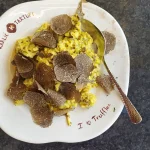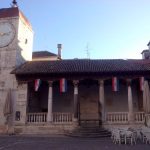Writing one of our popular 25 Things articles, is often a very time consuming and difficult tasks. Not so with Rovinj, there are more things to say and stories to tell about Istria’s most beautiful and romantic town than those listed below. Almost every one of the picturesque colourful buildings of the old town has its own story to tell and even though Rovinj, located at the western coast of the Istrian peninsula, is a small town, you can find out something new every time you visit it.
1 Rovinj used to be an Island
What is known today as the old town of Rovinj used to be an island. In 1763, when the town was under Venetian rule, the mainland and the island were connected and the town begun its further development.
2 Brief History of Rovinj
It is unclear when exactly the town was founded. It was first mentioned as the Castrum Rubini in the 5th century, when it was under Roman rule. After invasions by Huns and Ostrogoths, it was under Byzantine from 539 on. It changed many rulers and suffered invasions while struggling for autonomy. In 1283, it became part of the Venetian Republic, Rovinj gradually developed and flourished in the 17th and 18th century. After the fall of the Venetian Republic (1797), the town was briefly under Austrian and the rule of Napoleon. The Austrians took over again in 1813 and Rovinj developed further. Cement production, a tobacco factory and, a sardine canning factory and a host of other buildings were built. Following WW I, Rovinj became part of Italy and was under German occupation from 1943-45. In 1947, Rovinj became part of the Yugoslav Republic of Croatia.
3 The Language in Rovinj
The inhabitants of Rovinj speak a very specific language, one you can’t really call a dialect, as everyone seems to have his/her own version of verbal communication. A sentence is often begun in Italian, continued in Istrian dialect and finished in Croatian. In-between, there is the occasional German word. Officially, as the whole of the Istran peninsula, Rovinj is bilingual and the languages spoken are Croatian and Italian. Unfortunately, the Rovinj specific dialect has found a place in the UNESCO “Red Book of Seriously Endangered Languages”.
4 Rovinj is Croatia’s Top Tourist Destination
With a total of 3.3 million (2015) overnight stays, the small town (some 14,000 inhabitants) of Rovinj is Croatia’s tourism champion, ahead of Dubrovnik, Poreč, Medulin and Umag. This fact shouldn’t scare you away, as the old town and the whole centre of Rovinj has succeeded in remaining a wonderfully romantic, uniquely charming and authentic small town and it is only in the months of July and August that you might have a hard time finding a nice spot to enjoy the sunset with a nice cocktail.
5 The Old Town of Rovinj
You do not have to be a very skilled photographer to make the most beautiful and romantic photos of your lifetime in Rovinj’s old town. There are countless motifs of passages to the sea, balconies, vivid small shops, unique galleries and many more small Gothic, Renaissance and Baroque details you see during a half hour walk through the Carrera, Bregovita, Grisia and other streets which you pass through on your way to the largest baroque building of the Istrian peninsula, the Church of St. Euphemia. Begin your stroll by passing through the Balbi’s Arch, one of the seven gates of the city. The limited space, from the time Rovinj was an island, conditioned the construction of narrow houses, narrow streets and small squares. The characteristically built chimneys are a special feature of the old city as well. Thanks to the above-mentioned special features, the old city was proclaimed a monument of culture in 1963.
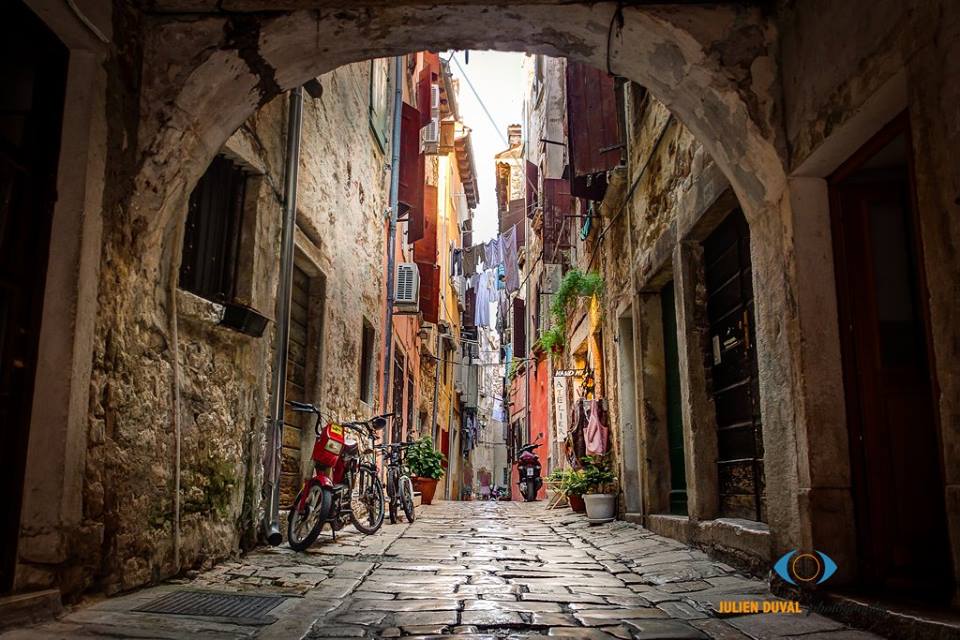
6 The Church of St. Euphemia
St. Euphemia is the patron saint of the town of Rovinj. Legend has it that the stone-made sarcophagus containing the remains of the Christian martyr, which is exhibited within the impressive church, came floating to the shores of Rovinj during a storm. The Rovinj landmark on top of the hill is also known as the Basilica of St. Euphemia and dominates the skyline of the old town. The church contains several treasures and works of art, such as Gothic statues from the 15th century, as well as paintings from the 16th and the 17th centuries. The bell tower resembles the tower of St Mark’s Basilica in Venice. The Tower of the church is the highest point in Rovinj and offers an enchanting view of the town and the archipelago that surrounds it. On top of this 60 m-high tower stands the statue of Saint Euphemia, serving as a wind vane. Rovinj celebrates St. Euphemia’s Day on September 16 and becomes the centre of the Istrian peninsula on that day.

7 The Nature around Rovinj
Besides itself being one of the most beautiful and romantic towns of the Croatian (and Italian) Adriatic Sea shores, the nature surrounding Rovinj offers some fantastic sights, such as the islands of the Rovinj archipelago, the Golden Cape Park Forest, the Palud Ornithological Reserve, Saline and the Lim Channel/Fjord/Bay.
8 The Lim Bay
The Lim Bay is a protected landscape with slopes that are covered in different forms of evergreen shrubs and different kinds of oak trees. It is located north of Rovinj towards Vrsar and Poreč, some 15 minutes by car. This flora diversity on a relatively narrow area represents a unique phenomenon and is of special ecological value, while also being a breath-taking sight. Romuald’s Cave is located nearby and can be reached by climbing through the 360 meter-long woods. The oldest remnants of the early man in Istria were found in this cave. Along with the cave bear, cave lion, leopard, wolf, fox, brown bear, cave hyena, snow rabbit…a total of 41 animal species were found in the cave. There is no danger of wild animals there and if you like fish, there is an excellent fish restaurant there.
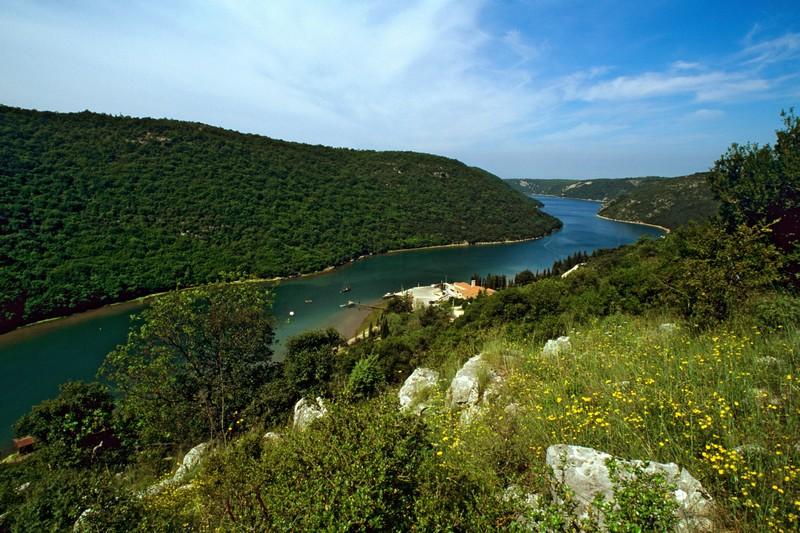
9 The Palud Ornithological Reserve
Ornithologists have thus far recorded over 200 bird species in the Palud Cove Ornithological Reserve located eight kilometres southwest of Rovinj. Since hunters are not allowed into the park, there are also a lot of pheasants, partridges and quails here. Various types of wild duck, water-hens, grebes and common snipes, garden warblers, golden orioles, woodpeckers, tawny pipits and shrieks live and nest here continuously. Besides thick authentic forests with beautiful specimens of pubescent and holm oak, the northern part of the wetlands includes a real rainforest with huge willow trees. The gulls nest on the Two Little Sisters Islands (Dvije sestrice), whereas the Gustinja Cape is a unique ‘forest vegetation reserve’ due to the very precious holm oak. For as little as 50 HRK per person you can get a guide and equipment for bird watching at the reserve.
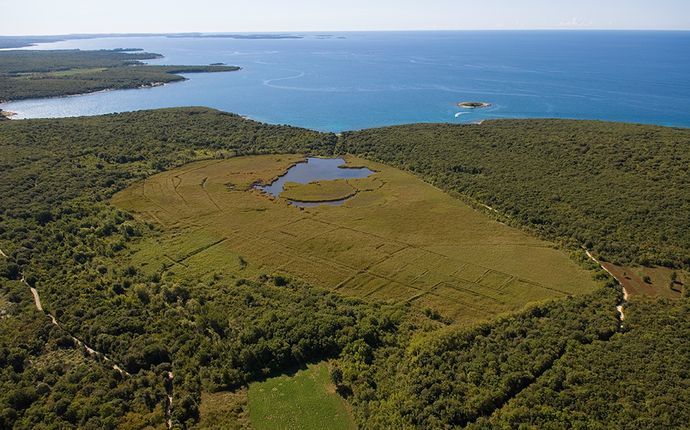
10 The Golden Cape Park Forest
The Golden Cape Park Forest is located within walking distance from the centre of Rovinj. Besides Dubrovnik’s Trsteno Park, Zlatni rt (Golden Cape) is the most significant park area at the Croatian side of the Adriatic Sea coast. Apart from a thousand indigenous and naturalized plant species, such as the holm oak and Alpine pine communities, many other species have been brought to this centuries-old shade – cedar trees, stone pine trees and ten types of cypress trees that contribute to the Mediterranean atmosphere of the forest park. There is an Info Desk in the park where you can get all information on rock climbing and bird watching. The Golden Cape Park Forest is practically “attached” to some of the most beautiful beaches of this part of the Istrian peninsula.
11 The Rovinj Archipelago and the Coastline
The natural landscape of the Rovinj archipelago and its coastline are part of the of ‘Landscapes of Outstanding Value’. Once you have seen it, you’ll understand why. The indented coast, holm oak, Alpine and Bruce pine forests and the special agricultural spaces amaze and capture with their beauty. The Protected Natural Heritage ‘Landscape of Outstanding Value’ stretches from St. John’s Cape (Rt Sv. Ivana) to Barbariga and encompasses all twenty Rovinj islands and islets and the coastal area up to the distance of 500 m from the coastline.
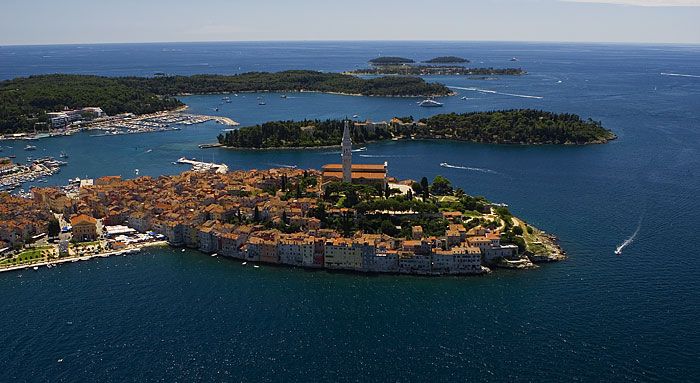
12 Rovinj’s Islands – The Beginning of Tourism in Rovinj
The St Andrew Island (Otok Sv. Andrija, also known as Crveni Otok), occupying an area of 23 hectares, is the largest island of the Rovij archipelago, followed by the beautiful St. Catherine’s Island (Otok Sv. Katarine), a true rarity in terms of vegetation. Both islands are located very close to Rovinj, have hotels built on them and can be visited. Botanists have recorded as many as 456 plant species in the area. n 1890, Georg Hűtterott, a successful entrepreneur of German origin bought four islands and in the years to come added land in the broader region of the present Golden Cape – Zlatni Rt, which he slowly proceeded to enrich with both Mediterranean and exotic plant species. In 1908, he published a booklet entitled ‘’Climate Resort Cap Aureo near Rovinj, Istria”. Having invested in the islands of St. Andrija and Maškin he received respectable guests there and laid the foundation of tourism in Rovinj. Count Milewski, a nobleman of Polish-Lithuanian origin, purchased the island of St. Katarina.
13 The Beaches of Rovinj
From one of the most luxurious beaches and beach bars on this side of the Adriatic Sea, located underneath the Monte Mulini Hotel, over beaches located practically in the centre of the town (Monte Beach), a host of beaches in resorts and camps which offer all imaginable equipment for fun and sport at the sea, to small hidden beaches and embayments, Rovinj and its surroundings offer it all. The beaches of Rovinj, as almost everywhere along the Croatian coast, are getting better and more suitable for all generations of sea and sun lovers every year. Some of the country’s best beaches for disabled people are also located in Rovinj (the beach at the Orthopaedic and Rehabilitation Hospital “Prim.dr.Martin Horvat”). The most popular beaches, besides the mentioned ones include the Lone Bay, Golden Cape, Moulin Rouge, Škaraba, Gustinja, and many more.
14 Rovinj’s Orthopaedic Hospital
The Orthopaedic and Rehabilitation Hospital “Prim.dr.Martin Horvat” was built in 1888 and is among the oldest orthopaedic-rehabilitation institutes in this part of Europe. It is one of the best organised hospitals of the country. The hospital complex is located only 3 km northeast of the city centre along the seaside. Most of the 20 ha complex is located on a peninsula that jets out into the sea. A specially equipped beach for use by patients is accessible to all patients regardless of the degree of their handicap. In addition, the hospital has a number of sports grounds and an indoor swimming pool filled with warm seawater accessible for handicapped patients. The hospital is public owned and one of the finest examples of medical tourism in Croatia.
15 Rovinj’s Festivals
Rovinj traditionally hosts some exciting smaller festivals of jazz and other music, dance, art, media, retro culture and more. All of the festivals have in common that they are usually not out to attract huge crowds, and that they often include the whole city as a stage. Some of the most popular annual festivals taking place in Rovinj are the Dolce Vita Festival (which takes a break in 2016, but returns next year), the excellent Rovinj Jazz Festival, the Summer Sensual Days and Summer Salsa Festival dance festivals, the Grisia open air exhibition and the Weekend Media Festival.
16 Rovinj’s UNESCO Protected Batana Boats
In ports of this area, protected from the winds, numerous Rovinj batanas are berthed even today. The batanas are flat-bottomed boats protected by UNESCO due to their longevity and a traditional way of construction. This is the reason why the Batana House Eco Museum was established. This is a dynamic project that offers, besides a permanent exhibition of batanas and fishing tools, various events that ensure a unique experience of combining tradition and contemporary life, past and present, and the story about an ancient wooden vessel that still remains a part of Rovinj’s everyday life. The Museum has won numerous recognitions and the first prize at The Heritage – Excellence Club Congress, part of the Expo Museum and Heritage Fair in Cologne.
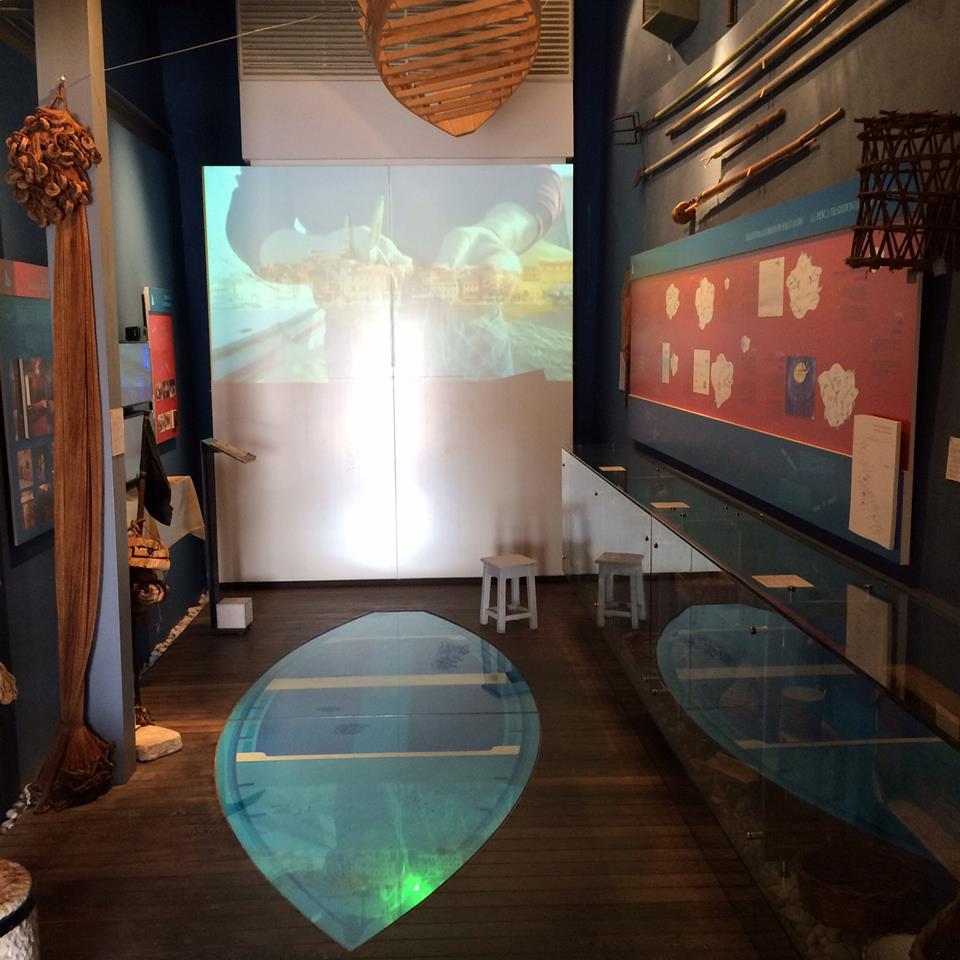
17 Bitinada Singing – The Beatboxing Fishermen of Rovinj
The tradition of making batanas is inseparable from the musical tradition of Rovinj that is represented by the bitinada, an authentic musical expression characteristic of Rovinj folk songs. According to the tradition, the bitinada was created by Rovinj fishermen who spent hours on their boats fishing or repairing the nets. Since their hands were engaged otherwise, they had to imitate instruments with their voices. Rovinj style beatboxing was born. The bitinadas became famous for their distinctive melodical conception similar to a game in which the sounds of various instruments are faithfully and masterly immitated and reproduced vocally, without any sheet of music. That’s why the songs are always different and new. The texts to the songs are Italian; the choirs performing bitinadas are called bitinaduri.Rovinj’s bitinada singing is on the list of protected intangible heritage of Croatia maintained by the Croatian Ministry of Culture.
18 Rovinj and Fishing
Now that we’ve explained the batana fishing boats and the harmony and melody loving fishermen of Rovinj, it is perhaps time to say that fishing has always been important for Rovinj and that there is still a small fish (sardines) canning industry which employs some 150 people. While there are still some fishermen living and working from Rovinj, many of the fishing techniques and traditional fisherman cuisine are being presented at various festivities which take place in Rovinj throughout the year.

19 Spacio
The place where Rovinj’s batana and fisherman culture, as well as bitinada singing and the wine come together is the Spacio. Occasionally, The Tourist Board of Rovinj and the local batana club organise evening gatherings at which the batanana owners make a moonlight tour and sing and the evening continues with more bitinada singing at the local Spacio. “It starts from a small pier near the main square and continues along the beautiful old town to the local tavern Spacio Matika in Švalba Street with sea entrance. Batana procession is accompanied by evocative music of Rovinj folk group Batana or Bitinaduri of the Cultural Society “Marco Garbin”. A traditional dinner with fish specialties will be served at Spacio Matika.”
20 Archaeological Park Monkodonja – Mušego
The hill-fort settlement Monkodonja is situated about 5 km south-east of Rovinj and was discovered in 1953 when the first excavations were carried out. Since 1997 comprehensive research has been carried out as well as the partial reconstruction of the architecture. The settlement, girded by strong dry walls, is located on the levelled top and wide terraces that originate back to the period when stone blocks were dug out and used for construction. It was inhabited in the period from 2000 to 1200 B.C. The grave tumuli on Mušeg are situated 1.5 km from Monkodonja. Grave monuments such as grave-mounds, with differently constructed details, with the radius of 11 meters and above, were constructed with large stone blocks. In the middle of every tumulus, there is a stone chest built with carefully carved and composed slabs. Their covering slabs were broken by grave thieves.
21 Rovinj’s Surroundings
Bale and Kanfanar are the small towns which are seen as the surroundings of Rovinj. Medieval Bale has been gaining attention and popularity. The town developed around the medieval castle of the Sardo and Bembo families. It is yet another typical Istrian town built on a hilltop with narrow streets and stone houses that create a special atmosphere. The town is dominated by the bell tower of the Parish Church of St. Julian, built at the end of the 19th century. The Bembo Palace has recently been completely restored, nearby is a fine example of a town loggia, whereas the town centre is under protection. In the 18th century Kanfanar takes on the role of municipal centre in the South West area of the Peninsula where the mild Mediterranean climate becomes one with the natural characteristics of the Istrian inland. Kanfanar is located near the legendary medieval Dvigrad ruins.
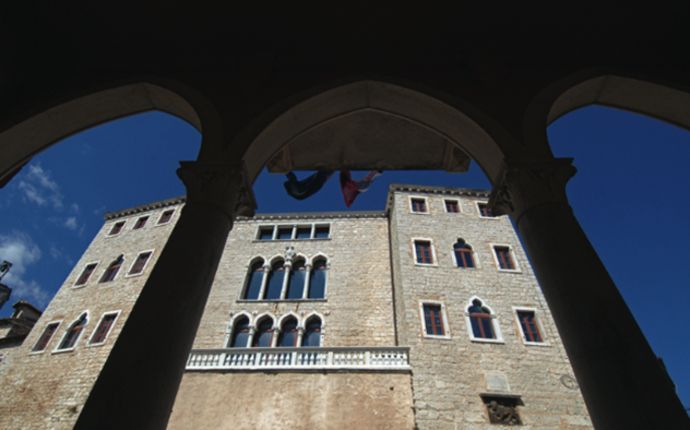
22 Dvigrad
Dvigrad, today is an uninhabited place dating from the Bronze age, is enclosed with a veil of mysteriousness and sacred rites of past times that circle the narrow streets and pass quietly through the churches painted with frescos done by an artist painter known as “Šareni Majstor” (Colorful master). Nearby, in the picturesque Kanfanar, you can enjoy the numerous traditional taverns, flavors and scents of the sea salt melting with the aroma of the rich Mediterranean vegetation. The medieval town of Dvigrad is dominated by the remains of the Roman basilica; legend has it that the undiscovered treasure of the British pirate Captain Morgan is buried near the place.
23 Wine, Olive Oil and Restaurants
The best wines and olive oils of the region of Rovinj and its surroundings come from Meneghetti and Dobravac, while the top restaurants of the region are the Monte, Puntulina, Wine Vault and Mediterraneo in Rovinj and the Meneghetti and La Grisia in Bale. Another site worth a visit for olive oil aficionados is the Uljara Grubić olive mill. Some of the best olive oil producers press their olives here. The mill is also interesting because it shows state of the art olive oil production next an exhibit of how it used to be done in the past. The best time to visit is in October.
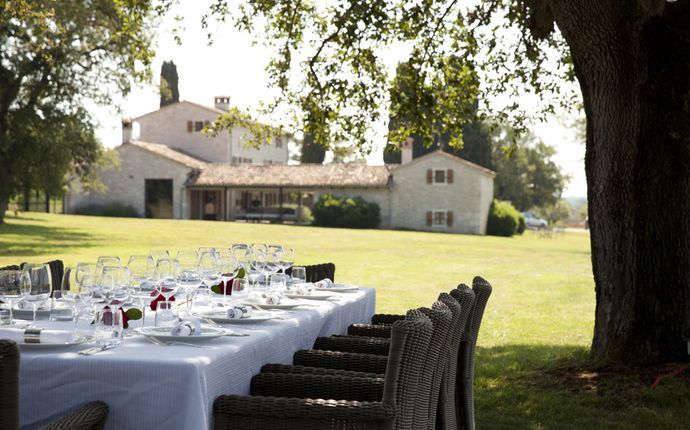
24 Day Trips to Venice
If the architecture of Rovinj reminds you of Venice, this is because from 1283 to 1797 Rovinj was one of the most important towns in Istria governed by the Republic of Venice. Day trips by ship to Venice on the other shore of the Adriatic Sea are available on Mondays, Wednesdays and Fridays. The trip lasts from 7am to 9pm, the stay in Venice lasts about five hours and the trip costs some 520 HRK.
25 Accommodation in Rovinj
Rovinj offers all kinds of accommodation for every budget. The Monnte Mulini and Lone Hotels are among the best luxury hotels of the country. Numerous other hotels, resorts, camps, hostels and private accommodation in villas with pool and apartments offer accommodation for families. Naturists have also been welcomed in Rovinjs camps and resorts for decades.

Photos: istrien7.com, Karin Hauenstein, Facebook, batana.org, Maistra, Julien Duval, istra.hr, visit-istria.hr, Villa Meneghetti


